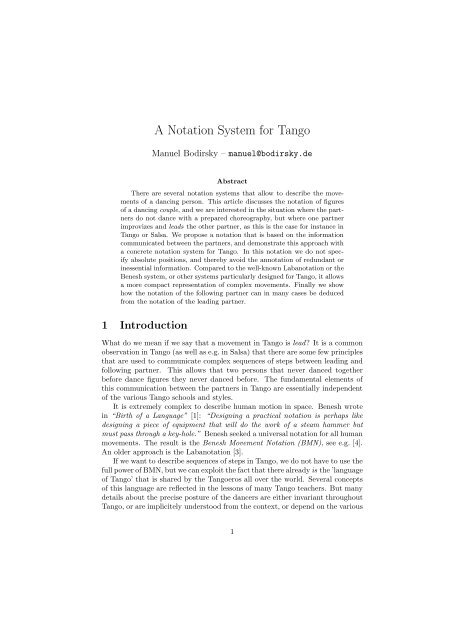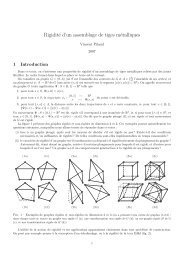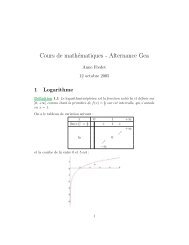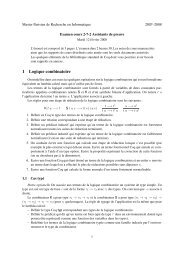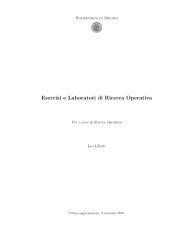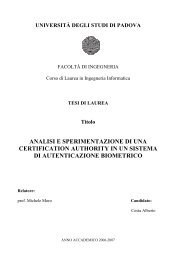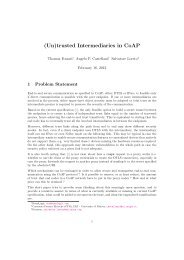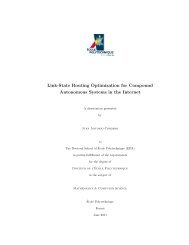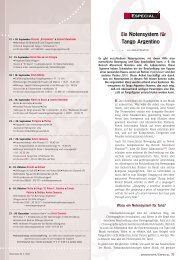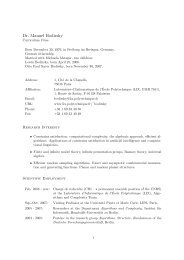You also want an ePaper? Increase the reach of your titles
YUMPU automatically turns print PDFs into web optimized ePapers that Google loves.
A <strong>Notation</strong> <strong>System</strong> <strong>for</strong> <strong>Tango</strong><br />
Manuel Bodirsky – manuel@bodirsky.de<br />
Abstract<br />
There are several notation systems that allow to describe the movements<br />
of a dancing person. This article discusses the notation of figures<br />
of a dancing couple, and we are interested in the situation where the partners<br />
do not dance with a prepared choreography, but where one partner<br />
improvizes and leads the other partner, as this is the case <strong>for</strong> instance in<br />
<strong>Tango</strong> or Salsa. We propose a notation that is based on the in<strong>for</strong>mation<br />
communicated between the partners, and demonstrate this approach with<br />
a concrete notation system <strong>for</strong> <strong>Tango</strong>. In this notation we do not specify<br />
absolute positions, and thereby avoid the annotation of redundant or<br />
inessential in<strong>for</strong>mation. Compared to the well-known Labanotation or the<br />
Benesh system, or other systems particularly designed <strong>for</strong> <strong>Tango</strong>, it allows<br />
a more compact representation of complex movements. Finally we show<br />
how the notation of the following partner can in many cases be deduced<br />
from the notation of the leading partner.<br />
1 Introduction<br />
What do we mean if we say that a movement in <strong>Tango</strong> is lead? It is a common<br />
observation in <strong>Tango</strong> (as well as e.g. in Salsa) that there are some few principles<br />
that are used to communicate complex sequences of steps between leading and<br />
following partner. This allows that two persons that never danced together<br />
be<strong>for</strong>e dance figures they never danced be<strong>for</strong>e. The fundamental elements of<br />
this communication between the partners in <strong>Tango</strong> are essentially independent<br />
of the various <strong>Tango</strong> schools and styles.<br />
It is extremely complex to describe human motion in space. Benesh wrote<br />
in “Birth of a Language” [1]: “Designing a practical notation is perhaps like<br />
designing a piece of equipment that will do the work of a steam hammer but<br />
must pass through a key-hole.” Benesh seeked a universal notation <strong>for</strong> all human<br />
movements. The result is the Benesh Movement <strong>Notation</strong> (BMN), see e.g. [4].<br />
An older approach is the Labanotation [3].<br />
If we want to describe sequences of steps in <strong>Tango</strong>, we do not have to use the<br />
full power of BMN, but we can exploit the fact that there already is the ’language<br />
of <strong>Tango</strong>’ that is shared by the <strong>Tango</strong>eros all over the world. Several concepts<br />
of this language are reflected in the lessons of many <strong>Tango</strong> teachers. But many<br />
details about the precise posture of the dancers are either invariant throughout<br />
<strong>Tango</strong>, or are implicitely understood from the context, or depend on the various<br />
1
1 INTRODUCTION 2<br />
schools and styles in <strong>Tango</strong>, and do not have to be communicated between<br />
the partners. I propose to use the in<strong>for</strong>mation that is exchanged between the<br />
partners as the fundamental elements to annotate figures and choreographies.<br />
For music there already exists a well-established notation system. Music<br />
scores have many applications. Most importantly, they are a tool <strong>for</strong> communication,<br />
and scores are used to exchange in<strong>for</strong>mation between composers,<br />
conductor, and musicians. The notation system <strong>for</strong> music is also a devise <strong>for</strong><br />
composition on an abstract level. It should be emphasized that this system does<br />
not define how music can look like. However, its usefulness is undisputed. This<br />
is even so despite the fact that it requires certain practice to use it fluently. For<br />
a beginner, it can be hard to grasp a melody from its notation only.<br />
This text does not try to define or to <strong>for</strong>malize <strong>Tango</strong>, which is impossible.<br />
It is also not a text on how to learn <strong>Tango</strong>. I rather want to suggest a simple<br />
notation that dancers might use to structure the zoo of figures they learn, to<br />
discuss figures in the same terms with other dancers, and to satisfy their curiosity<br />
about the system behind the things that they usually manage intuitively.<br />
The Rôle of Abstraction. A movement of the legs might induce at some<br />
point the movement of the whole body. More specifically, if <strong>for</strong> example a person<br />
has the weight on the left leg, moves the right leg to the front, and ends in a<br />
position where the weight is on the right leg, we know that the person moved<br />
to the front. The precise time point from when to when the center of the body<br />
moves is not spelled out in detail. This would be a difficult task, since it very<br />
much depends on various factors, musicality, speed, next movements, size of the<br />
movements etc. For our system it is only relevant, that the weight of the body<br />
moved from above the supporting leg in the previous state to the position above<br />
the other leg.<br />
<strong>Notation</strong> of movements has to make many abstractions. For instance, we do<br />
not want to specify absolute time points in the notation of a <strong>Tango</strong> figure – this<br />
would often not make sense, since at each stage the speed could be doubled or<br />
halved or varied otherwise, according to the musicality of the dancing couple.<br />
Unlike several notation systems in the literature, we also do not specify absolute<br />
positions – the size of the movements, the angles of rotations all very much<br />
depend again on the music, the physics of the dancers, the situation in the<br />
salon etc. I think that this strong abstraction is necessary. Benesh writes in<br />
“Birth of a Language” [1]: “The essential need <strong>for</strong> simplicity cannot be over<br />
emphasized. Simplicity does not necessarily mean omitting and reducing the<br />
value of things, it means the embracing of everything necessary into a simple<br />
unified theory or concept”. However, we should not expect too much: many<br />
figures that feal simple and look natural are indeed very complex, and are only<br />
mastered by a large amount of practice. Any notation notation system must<br />
trade off between universality and simplicity.<br />
Personal Pronouns. I frequently use the pronoun ‘we’, which is meant in<br />
the sense of ’the reader and I’. I would also like to make use of the richness
2 NOTATION DESIGN PRINCIPLES 3<br />
of the English language, which supports the concept of grammatical gender 1 ,<br />
and from now on we let the leading person be male and the following person be<br />
female to conveniently distinguish them in text.<br />
Outline. This article is organized as follows. We start with a general discussion<br />
of principles <strong>for</strong> notation systems <strong>for</strong> dances with leading and following<br />
partner. Section 3 introduces popular concepts in <strong>Tango</strong> that will be useful to<br />
introduce our notation. In Section 4 we describe the alphabet of our notation,<br />
in Section 5 we show how to combine the symbols to sequences that denote<br />
<strong>Tango</strong> figures. We illustrate the notation with rotations, which are notoriously<br />
difficult to annotate. Section 7 shows an application of the notation: we show<br />
several ways how the notation of figures can be trans<strong>for</strong>med to obtain new figures.<br />
In Section 8 we discuss how it is often possible to predict the notation of<br />
the following person from the notation of the leadings person. We close with a<br />
demonstration of the potential of the new notation system, and annotate parts<br />
of a choreography of Juan Carlos Copes in the film <strong>Tango</strong> directed by Carlos<br />
Saura [5].<br />
2 <strong>Notation</strong> Design Principles<br />
In this section we develop principles <strong>for</strong> the design of notation systems <strong>for</strong> dances<br />
with a leading and a following partner. The leading partner wants to dance a<br />
certain figure with his partner, but the following partner does not know which<br />
figure. Leading is the non-verbal communication of this intention to the following<br />
partner. Dances like <strong>Tango</strong> and Salsa have some few principles <strong>for</strong> leading.<br />
In these dances, most choreographies can be lead, sometimes even if they contain<br />
figures that the following partner never danced be<strong>for</strong>e.<br />
This communication bears extra complexity <strong>for</strong> notation systems; it is extremely<br />
complex to keep track of all the involved elements that constitute successful<br />
leading. For example, to lead the partner into a certain step, we often<br />
need slight counter movements be<strong>for</strong>e we can actually per<strong>for</strong>m the main movement<br />
that indicates the step. Another difficulty is that the precise movements<br />
of the leading person heavily depend on the response of the partner. We believe<br />
that any notation system that is based on precise descriptions how two bodies<br />
move has fundamental problems with the annotation of leading and following.<br />
On the other hand, the mentioned non-verbal languages in <strong>Tango</strong> or Salsa<br />
turn out to be an advantage <strong>for</strong> the design of notation systems. Be<strong>for</strong>e we<br />
discuss how the new requirements might influence the design of a notation, we<br />
review the most systematically designed universal notation system, which is<br />
the Benesh Movement <strong>Notation</strong> (BMN). It is based on descriptions of absolute<br />
positions of the bodies of the dancers, and consequently we believe that <strong>for</strong> our<br />
purposes the BMN works on the wrong level of abstraction and is impractical.<br />
1 I often got the response from readers that every human language has a grammatical<br />
gender. This is not true; <strong>for</strong> instance Turkish and Korean do not have one.
2 NOTATION DESIGN PRINCIPLES 4<br />
Figure 1: Benesh Movement <strong>Notation</strong> <strong>for</strong> a frequent sequence in a choreography<br />
of Five <strong>Tango</strong>s by van Manen - it denotes a single <strong>for</strong>ward step of a single person.<br />
In the notation <strong>for</strong> this choreography of the one-act play a short-cut <strong>for</strong> this step<br />
was used, which can be found below.<br />
The Benesh Movement <strong>Notation</strong>. The Benesh Movement <strong>Notation</strong> is<br />
written within the so-called stave, which is a five-lined matrix <strong>for</strong> the human<br />
body. It is suited <strong>for</strong> the notation of running, rolling, falling, dancing, walking<br />
or any other <strong>for</strong>m of movement. BMN was used <strong>for</strong> the notation of a <strong>Tango</strong><br />
choreography by van Manen; a single <strong>for</strong>ward step is analyzed as shown in Figure<br />
1. <strong>Tango</strong> dancers might have the impression that this is quite a lot to<br />
write <strong>for</strong> a single step <strong>for</strong> a single person. Indeed, already in the BMN of this<br />
choreography certain short-cuts were introduced. For instance the notation in<br />
the second part of Figure 1 replaced the notation in Figure 1. But we believe<br />
that the notation is still too explicit <strong>for</strong> such a fundamental and frequently used<br />
element in <strong>Tango</strong>.<br />
The design of the BMN is based on two principles, called axioms in [1].<br />
1. The notation system should be visual.<br />
2. The notation should take the perspective of a third person watching<br />
the dancer. This person has a two-dimensional reception of the threedimensional<br />
dancer in the space, and this justifies the usage of the stave.<br />
A notation is visual if it exploits symmetries in space. For example, if<br />
we introduce → as the symbol <strong>for</strong> a certain movement to the front, then the<br />
corresponding backwards movement is naturally denoted by ←.<br />
For the notation of dances with leading and following we still believe in the<br />
first principle. However, we would not require to use a stave. The reason <strong>for</strong> this<br />
difference to Benesh’s design decisions is that <strong>for</strong> our purposes Benesh’s second<br />
principle is not met. For a dancing couple in <strong>Tango</strong>, the point of reference is<br />
the partner, and not potential spectators.<br />
f
3 PRELIMINARIES 5<br />
We now want to <strong>for</strong>mulate two additional design principles. Because of the<br />
importance of the connection between the music and the dance, we would like to<br />
have the possibility to write a choreography in our language directly below the<br />
corresponding score of the music, as this is the case in BMN. <strong>Notation</strong> that is<br />
compatible with music scores seams impossible <strong>for</strong> other systems that have been<br />
proposed <strong>for</strong> <strong>Tango</strong>, e.g. <strong>for</strong> the descriptions of the figures in Castro’s system [2].<br />
As in many other descriptions <strong>for</strong> social dance, they are based on a picture <strong>for</strong><br />
the sequence of steps of the partners. The paper represents the dance floor,<br />
and the feet of the partners are shown, decorated with numbers according to<br />
the order in which the steps are made. Since these pictures represent absolute<br />
positions in space, we might have problems to fit the pictures <strong>for</strong> a sequence of<br />
rotations of the couple sequentially below the lines of music.<br />
The last principle we want to <strong>for</strong>mulate is devoted to leading and following.<br />
If a figure is lead, then the movements of the following person are to some extent<br />
determined by the leading partner. We would like to have a system where the<br />
notation <strong>for</strong> the following person can in such cases be deduced from the notation<br />
of the leading person. One of the main underlying ideas of how this is done in<br />
<strong>Tango</strong> (and Salsa) is that the following person always dances what is natural<br />
or convenient. The leading person on the other hand tries to create situations<br />
where there is a unique most convenient way <strong>for</strong> the following person. It is<br />
<strong>for</strong> <strong>Tango</strong> dancers clear that the leg carrying the weight can impossibly move<br />
without changing the weight to the other leg, and there<strong>for</strong>e we use the other leg<br />
to move. The movement of the leading upper body determines the direction of<br />
this step of the following partner. We will treat this in detail in Section 8.<br />
We summarize the four mentioned language design principles.<br />
1. The notation should be visual.<br />
2. The notation should describe the state and movements of a dancer relative<br />
to the partner.<br />
3. It should be possible to sequentially write down the notation, according<br />
to the linear order of the movements given by time. Thus it should be<br />
possible to write the notation together with the score of an associated<br />
piece of music.<br />
4. It should be possible to predict the notation <strong>for</strong> the following partner from<br />
the notation <strong>for</strong> the previous state of the following partner, and from the<br />
notation <strong>for</strong> the leading partner.<br />
3 Preliminaries<br />
In <strong>Tango</strong>, most of the time a dancer carries the weight on one leg, which is also<br />
called the supporting leg. The free or non-supporting leg that does not carry<br />
the weight can move. The diagram in Figure 2 shows the typical positions of<br />
the free leg of a person standing on its left leg in the hatched area. The person<br />
is oriented to the right, i.e., it faces the right side; accordingly, Position 2 in
3 PRELIMINARIES 6<br />
: 1 to 2, 4 to 1, 6 to 2<br />
: 1 to 3, 6 to 1, 5 to 1<br />
: 1 to 4, 2 to 1, 5 to 4<br />
: 3 to 1, 1 to 6, 1 to 5<br />
: 3 via 1 to 2<br />
: 4 via 1 to 3<br />
<br />
<br />
: 2 via 1 to 3<br />
: 3 via 1 to 4<br />
։: 4 via 1 to 2<br />
և: 2 via 1 to 4<br />
5 6<br />
00 11<br />
00 11<br />
00 11<br />
00 11<br />
4 1 2<br />
Figure 2: Schema <strong>for</strong> the various positions of the right leg of a dancer, standing<br />
on his left leg in the hatched area, and oriented to the right side. The arrows<br />
denote the changes between these positions.<br />
Figure 2 corresponds to a front step of the person. We chose this orientation of<br />
the illustration because it will fit the direction in which we read our notation.<br />
The precise placement of the feet within or close to the encircled areas is not<br />
specified. They also might be oriented in various ways. We do not keep track<br />
of this in<strong>for</strong>mation in our core language, since the position of the feet can most<br />
of the time be deduced from the context.<br />
It is typical <strong>for</strong> <strong>Tango</strong> that when we change from some position of the free<br />
leg to another, we usually first return to Position 1 (again, see Figure 2). It is<br />
also one of the special elements of <strong>Tango</strong> that sometimes there is no movement<br />
at all, but the dancers rest in the music.<br />
When do we call a sequence of movements a figure? I adopt the convention<br />
that a figure is a sequence of steps or other movements that ’belong together’<br />
<strong>for</strong> certain reasons. Such reasons might be of historic, dynamic, melodic or<br />
rhythmic nature. It might be possible to divide a figure into smaller constituting<br />
parts; however, they still <strong>for</strong>m a certain entity, <strong>for</strong> instance because they are<br />
particularly convenient to dance in combination. The sequence might also be<br />
grouped together and <strong>for</strong>m an entity because of didactic reasons. It might<br />
be best to teach the whole sequence, instead of teaching its parts. The most<br />
famous figure of <strong>Tango</strong> is the so-called ‘base’. We will use the base to illustrate<br />
the notation in Section 5.<br />
There are several aspects of <strong>Tango</strong> that might vary a lot, depending on<br />
dancer, couple, and style: How much do you bend the knee of the leg carrying<br />
the weight, how much the other knee? How do the partners hold each other at<br />
hands and arms? Are the upper bodies touching at the front, more at the right<br />
side, or not at all? How much do you use vertical movements and impulse <strong>for</strong><br />
leading? How close are the feet and the knees in position one? How do you step<br />
<strong>for</strong>ward with your feet (hills first, hills last, the whole foot)? Such questions are<br />
taught differently in different schools; we try to be as basic as possible and try<br />
not to specify such matters of style.<br />
3
4 THE ALPHABET 7<br />
A <strong>Notation</strong> <strong>System</strong> <strong>for</strong> <strong>Tango</strong>. In the notation system presented here we<br />
keep track of the states, the movements, and the communication of the dancers<br />
with respect to the following categories:<br />
1. Weight – The dancing person might stand on the left or on the right leg.<br />
2. Orientation of the upper body – In <strong>Tango</strong> one usually starts a dance standing<br />
in front of each other. But quite often while dancing your partner is<br />
more to your right or more to your left side, and you have your upper<br />
body turned towards him.<br />
3. Impulses of the upper body – Such an impulse of the leading person might<br />
<strong>for</strong> instance indicate a rotation to the following person. It might also cause<br />
that the upper bodies open to the left or to the right side.<br />
4. Relative state of the legs – This is the determining factor to describe the<br />
state of the lower body in <strong>Tango</strong>. It can be either open or crossed. The<br />
usefulness of this concept has also been recognized <strong>for</strong> teaching <strong>Tango</strong>.<br />
This concept is explained in detail below.<br />
5. Movement of legs – The movements of the free leg of the dancing person,<br />
i.e., the leg that does not carry the weight.<br />
Our notation system describes all states and movements during a dance<br />
with respect to these categories, we obtain a notation system that can be used to<br />
annotate <strong>Tango</strong> figures; the details of this system will be introduced in Sections 4<br />
and 5.<br />
4 The Alphabet<br />
The alphabet of the notation system consists of symbols <strong>for</strong> the notation of the<br />
state of the upper body, symbols that denote the state of the legs relative to<br />
the partner, and symbols <strong>for</strong> movements of the legs.<br />
We start with the upper body. The alphabet contains three symbols <strong>for</strong> the<br />
alignment of the shoulders: |, \, /. The first symbol stands <strong>for</strong> the state where<br />
the upper body is oriented straight towards the walking direction, whereas <strong>for</strong><br />
then second and third symbol the upper body is turned towards the left or the<br />
right, respectively. The second in<strong>for</strong>mation we denote is whether the leading<br />
partner gives some extra spin impulse with the upper body. For instance the<br />
symbol ⌊ denotes the situation where the upper body is directed straight to the<br />
partner, but at the same time there was some impulse that caused her upper<br />
body to turn to the left. This happens <strong>for</strong> example at the beginning of the wellknown<br />
backwards-ocho of the lady – we will come back to that in Section 5.<br />
Other symbols denoting such an impulse are <strong>for</strong> instance ⌊ and ⌈ . The last<br />
symbol combines the in<strong>for</strong>mation that the upper body is oriented to the right<br />
or to the left, and at the same time gives some extra impulse.<br />
To describe the relative positions of the legs, we use the two symbols o and<br />
x, to denote whether the state of the dancer is open or crossed. The concept
4 THE ALPHABET 8<br />
Figure 3: Pablo Villarraza and Dana Jazmin Frigoli: She is in a crossed, he is<br />
in an open state.<br />
of the relative state of the legs is defined with respect to the position of the<br />
partner. To understand these concepts imagine a line between the centers of<br />
the two partners that are facing each other. We say that a person is in the<br />
crossed state (with respect to his partner) if either the left leg is to the right<br />
of this line, or the right leg is to the left of this line. Otherwise the person is<br />
in the open state. This in<strong>for</strong>mation <strong>for</strong>ms an important part of the notation<br />
since it often influences which steps are possible next. The relative state is also<br />
important <strong>for</strong> the notation of rotations, which will be discussed in Section 6.<br />
Finally there are symbols <strong>for</strong> leg movements. They are divided into the<br />
symbols <strong>for</strong> half-steps ←, →, ↑, ↓, and the symbols <strong>for</strong> full steps: ։, և, , , ,<br />
<br />
, , <br />
, , <br />
: These are the possibilities to change between the positions shown<br />
in Figure 2. We also have the symbols ·, −, |, x to denote no leg movement. We<br />
use the dot ‘·’ if the legs are in standard position besides each other, the line<br />
‘−’ if the legs are apart in either a side or a front step, respectively, and a cross<br />
‘x’ if the leg is in position five or six (in this case the partner is in particular in<br />
the crossed state; see Figure 3).<br />
The movements of both partners are specified with the same notation, with<br />
a few exceptions <strong>for</strong> the leading partner. On of these exceptions is the symbol<br />
‘•’, which will be explained in the next section. Also the hooks <strong>for</strong> the impulse<br />
of the upper body are only used <strong>for</strong> the leading partner.<br />
We do not have explicit symbols <strong>for</strong> embellishments that are typical <strong>for</strong><br />
<strong>Tango</strong> – such as the so-called boleo, lapiz, gancho etc. But it will be easy to<br />
recognize from the notation in which situations such embellishments are possible.<br />
If needed, due to Principle 4 in Section 2, it is possible to notate the<br />
decorations along with the base language, <strong>for</strong> example with the universal Benesh<br />
Movement <strong>Notation</strong>.
5 THE NOTATION 9<br />
5 The <strong>Notation</strong><br />
For each partner, we annotate the movements by an alternating sequence of a<br />
symbol <strong>for</strong> the upper body, a symbol <strong>for</strong> the relative state of the legs, and a<br />
symbol <strong>for</strong> the leg movement. The symbol <strong>for</strong> the relative state is written below<br />
or above the symbol <strong>for</strong> the upper body, depending on whether the weight of<br />
the person is on the left or on the right leg. As we read from left to right,<br />
we imagine the leading person dancing <strong>for</strong>ward from left to right. Hence, ‘’<br />
denotes a <strong>for</strong>ward-step, and the symbol ‘|’ says that the upper body is oriented<br />
straight to the front with respect to the walking direction from left to right. We<br />
start with the movements of the leading person in the so-called base in <strong>Tango</strong><br />
Argentino.<br />
o<br />
| | o<br />
o //<br />
x<br />
։ o<br />
/| <br />
o<br />
o<br />
|<br />
| <br />
o<br />
o<br />
| (1)<br />
The non-supporting leg of the dancing person makes the next step as indicated<br />
by the following symbol <strong>for</strong> the leg movement. Note that in this figure the<br />
weight of the dancing person appears alternatingly at top and at bottom. This<br />
is typical <strong>for</strong> human walking, but not a strict rule: In fact every symbol <strong>for</strong> a<br />
combined movement in <strong>Tango</strong> can be considered as a short-cut <strong>for</strong> two simple<br />
movements. For example the following notation on the right is the abbreviation<br />
<strong>for</strong> the symbols on the left side. 2<br />
o<br />
|| | <br />
o o<br />
o<br />
/<br />
<br />
o<br />
|| o<br />
/ (2)<br />
It is interesting to write the notation of the following person directly below<br />
the notations of the leading person such that movements that happen at the<br />
same time are closest together. We call the two sequences also the tracks of a<br />
notation. We will later see in detail how the notation <strong>for</strong> the following person<br />
often follow from the notation <strong>for</strong> the leading person. We demonstrate this <strong>for</strong><br />
the base, and have a look at both tracks:<br />
o<br />
|| o<br />
| <br />
o<br />
o<br />
|<br />
/ o<br />
<br />
o //<br />
<br />
x<br />
x<br />
։ o<br />
/| <br />
o<br />
o<br />
|<br />
/և/ o<br />
x<br />
|| o<br />
<br />
o<br />
| <br />
o<br />
o<br />
| (3)<br />
2 The reasons to have these short-hands are manifold. Usually dancers count a combined<br />
movement as a single step, although it can be understood as two simple movements of the<br />
leg. For example we say that the base has eight steps. In this case simple and combined<br />
movements are counted with no difference. Having symbols <strong>for</strong> combined movements often<br />
allows concise descriptions if one partner dances two steps while the other partner dances one.<br />
Using short-hands whenever possible also puts the focus on the more complex parts of<br />
figures, where the usage of a short-hand is not possible, <strong>for</strong> instance in rotations, see Section 6.<br />
If the partners are simply walking together, using symbols <strong>for</strong> combined movements leads to<br />
the pattern that the weight always alternates from leg to leg.<br />
| | o<br />
o
5 THE NOTATION 10<br />
State number three of this figure is interesting: The fact that she is on his<br />
right front side indicated by / implies that his last side step must have been a<br />
little larger than her sidestep. Another interesting part of this sequence is step<br />
number five: While walking in three lines, a slight reorientation of his upper<br />
body causes her left leg to move back into the new direction, end she thus ends<br />
in front of her other leg: her legs are in the crossed state now.<br />
Anticodico. In the base she has her weight on the left leg if he has it on the<br />
right leg, and vice versa. We call this the parallel system. If she has her weight<br />
on the left leg, and he has it also on his left leg, and if the partners are facing<br />
each other, the line between the legs carrying the weight and the line between<br />
the other legs cross, and there<strong>for</strong>e the other system is often called the crossed<br />
system. To not confuse it with the crossed state of the leg mentioned above, we<br />
call the crossed system anticodico. Below we find a frequent sequence of steps<br />
danced in anticodico.<br />
But first we have to introduce the last symbol • in the notation <strong>for</strong> the<br />
leading partner. Usually, if he changes his weight, she realizes this at the points<br />
of contact of the partners, and changes her weight accordingly. If he wants to<br />
prevent this, he can do so by suppressing the signals that would make her change<br />
her weight. In other words, he pretends with his upper body to not change his<br />
weight, but in fact he does change it 3 . In this case we have to use the symbol<br />
‘•’, which we write on that side of the notation of the leading person, where she<br />
should then have her supporting leg (from his perspective). The real position<br />
of his weight is still specified by the side where we put o or x in the notations.<br />
4 In the base we do not have such change of weight. We there<strong>for</strong>e have a look<br />
at the so-called base cruzado.<br />
o<br />
|| o<br />
| <br />
o<br />
o<br />
|<br />
| •<br />
/ <br />
o<br />
o<br />
/։| | <br />
x o<br />
o<br />
|<br />
o<br />
|<br />
o<br />
<br />
/ <br />
o<br />
x<br />
/և| <br />
o<br />
x<br />
||<br />
o<br />
| <br />
o<br />
o<br />
| (4)<br />
In the base cruzado the symbol • also marks the change between parallel<br />
system and crossed system. The crossed system ends three steps later when she<br />
is in the crossed state again. The frequent use of both systems and changes<br />
between them is one of the fascinating elements of <strong>Tango</strong>. In the notation we<br />
can easily spot the differences: In the crossed system the weight is <strong>for</strong> both<br />
partners on the same leg, whereas in the parallel system both partners have the<br />
weight on different legs.<br />
3 This is in fact a quite frequent pattern in <strong>Tango</strong>, and one of the ways how the leading<br />
person might surprize the following person in subsequent steps.<br />
4 It might be the case that we have to put the symbol • at the same side where we already<br />
have the symbol ‘o’ or ‘x’ <strong>for</strong> the weight. This happens rarely, but is <strong>for</strong> instance the case if<br />
one partner leads her to change the weight from left to right, and back to the left again, while<br />
he is always standing on the same leg.<br />
<br />
| | o<br />
o
6 EXAMPLES 11<br />
Finally we give a example where a spin impulse of the upper body is an<br />
essential part of the figure: The backwards ocho. How does the leading person<br />
indicate that he wants her to make back steps while he accompanies her with<br />
side steps? We start like in the beginning of the base. After step number three<br />
he changes the weight to the right leg while turning her counterclockwise on her<br />
right leg: this in<strong>for</strong>mation is given by the symbols •<br />
⌊. o<br />
6 Examples<br />
o<br />
|| o<br />
| <br />
o<br />
o<br />
|<br />
| •<br />
⌊<br />
o<br />
o<br />
|<br />
o<br />
<br />
o<br />
⌈ o<br />
⌈ | <br />
o<br />
o<br />
| (5)<br />
/ <br />
x<br />
x<br />
/ x<br />
\\ |<br />
x o<br />
This section further illustrates the notation system and discusses famous figures<br />
in <strong>Tango</strong> Argentino. We start with examples from a group of figures known<br />
as rotations. The notation of rotations of the dancers is one of the greatest<br />
challenges <strong>for</strong> notation systems.<br />
6.1 Rotations Around a Common Axis<br />
Most notation systems <strong>for</strong> <strong>Tango</strong> are based on a graphical notation of the absolute<br />
feet positions, and lines and arrows that indicate movements. For readability,<br />
these systems have to describe a complex rotation with several pictures.<br />
In contrast, we can sequentially specify rotations with the already introduced<br />
notation. Even <strong>for</strong> repeated rotations we do not need several pictures, but still<br />
annotate them with the two tracks <strong>for</strong> the two partners. Here we make essential<br />
use of the in<strong>for</strong>mation we have about the upper bodies. Although a rotation<br />
changes the direction of the partners in space, we still read and write from left<br />
to right only, since we only keep track of relative positions with respect to the<br />
partner.<br />
The following is a right-rotation in the parallel mode where both partners<br />
walk around a common center. The notation is not symmetric between the partners:<br />
She dances the pattern front-side-back-side, while he only takes <strong>for</strong>ward<br />
steps.<br />
⌊ o<br />
o<br />
/ o<br />
|/ ⌈ x o<br />
o<br />
/ o<br />
| · / · |<br />
o o<br />
o<br />
|/ | <br />
x o<br />
o<br />
/ x<br />
\\ | <br />
x o<br />
o<br />
/ o<br />
|<br />
These <strong>for</strong>ward steps are often combined with so-called sacadas, i.e., he invades<br />
with his leg the space that she just left; this creates the impression that<br />
his legs cut into her legs – which is what the Spanish name says. See Figure 4<br />
(6)
6 EXAMPLES 12<br />
o<br />
\<br />
x<br />
\<br />
/ x<br />
/ o<br />
Figure 4: Several Sacada variants. Pablo is leading, Dana following; below we<br />
find the notation <strong>for</strong> the corresponding moments <strong>for</strong> him, and further below <strong>for</strong><br />
her.<br />
<strong>for</strong> some variants of that idea. In the last picture to the right, she dances a<br />
sacada, but he still leads this sacada.<br />
Doing sacadas properly is a question of timing; to stress this, we can in<br />
the case that the above rotation is danced with two sacadas use the different<br />
notation below.<br />
⌊ · / <br />
o o<br />
o<br />
/ o<br />
| · / / <br />
o x<br />
o<br />
⌈ o<br />
/ o<br />
| · / · |<br />
o o<br />
o<br />
|/ −/ | <br />
x x o<br />
o<br />
/ o<br />
/ x<br />
\\ | <br />
x o<br />
o<br />
/ o<br />
|<br />
For comparison, we also show the analogous right rotation in anticodico<br />
(without sacadas), and on the left side the corresponding left rotation.<br />
o<br />
⌊/ | <br />
x o<br />
o<br />
/ o<br />
⌈/ | ·<br />
x o<br />
o<br />
/ · o<br />
| ⌈ o<br />
x<br />
\ o x<br />
|\ ⌊ ⌉<br />
o o<br />
o<br />
| · / · |<br />
o o<br />
o<br />
|/ | <br />
x o<br />
o<br />
/ x<br />
\\ | <br />
x o<br />
o<br />
\ o<br />
| | <br />
o<br />
x<br />
\ o<br />
| \ / <br />
o x<br />
x<br />
/ o<br />
| / |<br />
o o<br />
6.2 Change of Direction<br />
In this subsection we present a not so frequently seen but still standard figure<br />
that tends to surprise her twice. It is a beautiful walking sequence in anticodico,<br />
⌈<br />
x<br />
x<br />
\<br />
(7)<br />
(8)
7 TRANSFORMATIONS 13<br />
during which the partners usually turn by 360 degrees.<br />
| <br />
o<br />
o<br />
/ •<br />
/ <br />
o<br />
o<br />
| o<br />
\\ | <br />
o o<br />
o<br />
/։/ ։<br />
x<br />
o<br />
/<br />
o<br />
| / / <br />
o o<br />
x<br />
/ o<br />
// | <br />
x o<br />
o<br />
/և/ և<br />
o<br />
x<br />
/<br />
After the first two steps the partners are in the crossed mode as in the base<br />
cruzado. The first part of the turn starts with the leading person, who changes<br />
on her right side his walking direction towards her, while she is still walking<br />
backwards. The next step is the crux of the figure: with respect to the line of<br />
their joint movement, he is now on her other side, and leads her from a back step<br />
into a front step, while turning her around by 180 degrees. The final turn after<br />
the side step, that restores the original walking direction, is lead by another<br />
redirection of his upper body.<br />
Again, the reflected version of this figure yields another interesting combination.<br />
We do not reflect the ending, such that both the original and the reflected<br />
figure end in step 4 of the base cruzado.<br />
7 Trans<strong>for</strong>mations<br />
| <br />
o<br />
o<br />
| •<br />
| <br />
x<br />
x<br />
\ ։| / <br />
o o<br />
o<br />
/ o<br />
|| ։<br />
o<br />
o<br />
/<br />
o<br />
| | | <br />
o o<br />
o<br />
\և\ \ <br />
x o<br />
x<br />
\ o<br />
| / և<br />
o<br />
x<br />
/<br />
In Section 6 we saw how to change a rotation in the parallel system to a rotation<br />
in the crossed system, and subsequently how to reflect the figure to obtain a leftrotation.<br />
Other trans<strong>for</strong>mations between figures are reversion between back and<br />
front and inversion – where we dance a figure from the end to the beginning.<br />
Finally we can swap the figure which means that he does her steps and vice<br />
versa. This does not mean, however, that she has to play the leading part:<br />
It is in most cases possible to lead all figures in the presented system in the<br />
mentioned trans<strong>for</strong>med ways, even if we combine several trans<strong>for</strong>mations. With<br />
our notation it is easy to give <strong>for</strong>mal rules how to reflect, reverse, inverse, and<br />
swap annotations of many figures. Here, the first two design principles turn out<br />
to be useful. For reflection <strong>for</strong> instance, it suffices to reflect the positions of the<br />
weight, to reflect all symbols <strong>for</strong> side movements, and to reflect all symbols <strong>for</strong><br />
the upper body from left to right.<br />
Reflecting a figure might be difficult in practice, if the couple got used to<br />
an asymmetric position, in particular because usually they hold each other differently<br />
on both sides. An obstacle to per<strong>for</strong>m the other trans<strong>for</strong>mations in<br />
practice is that the leading person should not make too many backward steps,<br />
since in the salon there might be another couple behind him.
8 FOLLOWING AND LEADING 14<br />
8 Following and Leading<br />
One of the goals in the design of the notation was that the notation <strong>for</strong> the<br />
following partner can often be deduced from the notation <strong>for</strong> the leading partner.<br />
As already mentioned, this is <strong>for</strong> example not possible in Castro’s system. It is<br />
not obvious, whether the presented notation achieves this goal.<br />
In this section we demonstrate how the notation of her next movement and<br />
state can often be deduced from the notation of her previous movement and<br />
state, and from the notation of his previous state and his next movement and<br />
state. We will explain how to locally deduce the notation <strong>for</strong> the following<br />
person in several steps. Consider the diagrams in Figure 9, which first show<br />
the first non-trivial situation in the backward ocho and the right rotation in<br />
<strong>Notation</strong>s 5 and 7, respectively. We would like to find out the symbols that<br />
could replace the question marks. We proceed as follows:<br />
1. Using the in<strong>for</strong>mation of the orientation and impulse of the upper bodies,<br />
and the relative positions of the legs, we deduce the relative positions of<br />
centers of the partners.<br />
2. With the in<strong>for</strong>mation about his leg movement, and the in<strong>for</strong>mation whether<br />
the weight changes between his movement, we can figure out the new position<br />
of his center.<br />
3. The in<strong>for</strong>mation about the new position of his center, and the in<strong>for</strong>mation<br />
about the new relative orientation of his upper body determine whether<br />
her center, and consequently her legs have to move to some direction.<br />
4. Her new relative position, and the in<strong>for</strong>mation about the new orientation<br />
and impulse of his upper body determine the new orientation of her upper<br />
body.<br />
5. If indicated by him (check <strong>for</strong> the symbol •), she changes the leg carrying<br />
her weight in the new position.<br />
If we apply this procedure to Figure 9, we obtain the symbols as they were<br />
shown in <strong>Notation</strong> 5 and <strong>Notation</strong> 7 be<strong>for</strong>e.<br />
· •<br />
⌊ o<br />
o<br />
| · ⌊ o<br />
o<br />
/ (9)<br />
/ ?? ·<br />
x<br />
x<br />
/ ??<br />
9 A Part of a Choreography<br />
This section contains the scores <strong>for</strong> approximately the first 30 seconds of a<br />
choreography of Juan Carlos Copes; he dances the choreography in a film called
REFERENCES 15<br />
‘<strong>Tango</strong>’ [5]. The music is Recuerdo by Osvaldo Pugliese.<br />
| | | | | | | <br />
o o o o o o o<br />
o<br />
|| <br />
o<br />
o<br />
|։| −⌈−/ o o x<br />
−⌊<br />
x<br />
− x<br />
/և/ <br />
o<br />
x<br />
| |<br />
• o<br />
o<br />
| o<br />
| o<br />
| o<br />
| o<br />
| o<br />
| o<br />
|| <br />
o<br />
o<br />
|| և<br />
o<br />
o<br />
| x<br />
\\ / <br />
x x<br />
o<br />
/։/ |<br />
o o<br />
| o<br />
\<br />
o<br />
x<br />
|\<br />
o<br />
/ <br />
o<br />
o<br />
// |<br />
x o<br />
<br />
// o<br />
o<br />
o<br />
|<br />
// ։<br />
x<br />
o<br />
/|<br />
o<br />
o<br />
/ o<br />
<br />
<br />
x<br />
/և/ o<br />
o<br />
/ o<br />
/ · | <br />
o<br />
o<br />
| o<br />
|\ | <br />
x o<br />
o<br />
/ o<br />
/ · | · / <br />
o o<br />
o<br />
/։/ <br />
x<br />
x<br />
/<br />
x<br />
/ o<br />
| · / · / <br />
o o<br />
o<br />
| | · | <br />
o o<br />
x<br />
\ o<br />
| · / · / <br />
o o<br />
o<br />
| o<br />
// և<br />
o<br />
x<br />
//<br />
x<br />
Note that we put the line break after the descriptions of a state. These<br />
descriptions are then repeated in the new line.<br />
About the author. Manuel Bodirsky is<br />
a mathematician and computer scientist at<br />
Humboldt-University Berlin. He dances<br />
<strong>Tango</strong> since April 2001.<br />
References<br />
[1] R. Benesh. Birth of a language. Theoria to Theory, 2, 1978.<br />
[2] M. Castro. <strong>Tango</strong>: The Structure of the Dance II. The Matrix. <strong>Tango</strong><br />
Discovery, 2003. 144 pages.<br />
[3] A. Kipling-Brown and M. Parker. Dance <strong>Notation</strong> <strong>for</strong> Beginners: Introduction<br />
to Labanotation/Benesh Movement <strong>Notation</strong>. Dance Books, 1984. 176<br />
pages.<br />
[4] J. McGuiness-Scott. Movement Study and Benesh Movement <strong>Notation</strong>. Ox<strong>for</strong>d<br />
University Press, 1983. 148 pages.<br />
[5] C. Saura. <strong>Tango</strong> (Film). Actors: Miguel Ángel Solá, Cecilia Narova; Music:<br />
Lalo Schifrin. 1997. 105 minutes.<br />
x<br />
|


